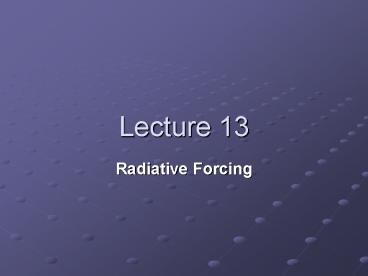Radiative Forcing - PowerPoint PPT Presentation
Title:
Radiative Forcing
Description:
Lecture 13 Radiative Forcing Reducing acid rain Sulfur emissions have been reduced Result: Less acid rain Acid Rain vs. Global Warming Reducing sulfur emissions ... – PowerPoint PPT presentation
Number of Views:87
Avg rating:3.0/5.0
Title: Radiative Forcing
1
Lecture 13
- Radiative Forcing
2
Radiative Forcing
- Definition A change in the net radiation at the
top of the atmosphere due to some external
factor.
3
Net Radiation
- Net radiation Incoming - Outgoing
- Positive net radiation
- Incoming gt Outgoing
- Negative net radiation
- Outgoing gt Incoming
4
Positive Negative Forcing
- Positive forcing ? warming
- Negative forcing ? cooling
5
Forcing and Feedbacks
Radiative forcing (external)
Internal response (including feedbacks)
Climate system
6
Forcing and Feedbacks
- Forcing is produced by an external process,
e.g. - Changes in solar flux
- Volcanic eruptions
- Human actions
- A feedback is a response to temperature changes
- Example Increased water vapor due to warming
7
More
- Anthropogenic increases in greenhouse gases are
considered forcings - Increases in greenhouse gases that are caused by
temperature changes are feedbacks
8
- The same gas can be involved in forcings and
feedbacks, e.g., CO2 - Forcing
- CO2 increase from burning of fossil fuels
- Feedback
- ?temp ? ?decay ? ?CO2
9
Comparing Causes of Temperature Change
- Assumption Larger radiative forcing ? larger
effect on temperature - Comparisons follow
- Source Intergovernmental Panel on Climate Change
(IPCC)
10
(No Transcript)
11
Positive Radiative Forcings
- Largest by far increased greenhouse gases
- Increase is almost entirely anthropogenic
12
Long-Lived Greenhouse Gases
1.66
CO2
0.48
CH4(methane)
0.16
N2O (nitrous oxide)
0.34
Halocarbons
2.64
Total
13
More About Greenhouse Gases
- Radiative transfer model
- Adding greenhouse gas reduces outgoing longwave
radiation (OLR) at top of atmosphere
14
Initial Equilibrium
Top of atmosphere
OLR
Absorbed Shortwave
Now, add greenhouse gas Keep temperatures fixed
15
Reduced Upward Flux
Top of atmosphere
OLR
Absorbed Shortwave
16
Net Downward Flux
Top of atmosphere
Net Flux
Result A positive radiative forcing
17
Negative Radiative Forcings
- Largest Increase in sulfate aerosols
- Mostly anthropogenic
18
Anthropogenic Sulfate Aerosols
- Coal and diesel fuel contain sulfur
- Burning of these fuels produces sulfur dioxide (a
gas) - In the atmosphere, this gas is converted into
particles
19
Effect of Anthropogenic Sulfate Aerosols on
Temperature
- Direct effect
- The aerosols themselves reflect sunlight
- This is similar to the effect of volcanic
aerosols - Indirect effect
- Sulfate aerosols act as condensation nuclei
- This increases the droplet concentration in
clouds - Result Increased cloud albedo
- Both effects tend to increase the Earths albedo
20
Evidence for Indirect Effect
Bright streaks are areas of enhanced
albedo Cause Emissions from ships Streaks called
ship tracks
21
Cause of Ship Tracks
- Ship exhaust contains aerosols
- The aerosols cause more droplets to form
- Cloud albedo is increased
22
Total Anthropogenic Effect on Climate
- Total Anthropogenic Climate Forcing
- sum of all anthropogenic forcings
- Mainly, greenhouse gases ()
- sulfate aerosols (-)
23
Net Anthropogenic Radiative Forcing (1750 2005)
- Best Estimate1.6 W/m2
- Positive.
24
(No Transcript)
25
(No Transcript)
26
(No Transcript)
27
Solar Irradiance
- Some evidence suggests solar irradiance may have
increased lately - Current estimate of forcing very small
- Note Evidence is very weak!
28
Engineering Solution to Global Warming?
- Sulfate aerosols cool the Earth
- Why not deliberately increase sulfur emissions?
- Answer Sulfur emissions contribute to acid rain
29
Damage to forests
30
Erosion of statues
31
Words on gravestone obliterated
32
Effect on Aquatic Life
- http//www.elmhurst.edu/chm/vchembook/195lakeeffe
cts.html - Canadian lakes have acidified by U. S. pollution
33
(No Transcript)
34
Reducing acid rain
- Sulfur emissions have been reduced
- Result Less acid rain
35
Acid Rain vs. Global Warming
- Reducing sulfur emissions reduces acidity
- Reducing sulfur emissions reduces cooling effect
of sulfate aerosols - Result Accelerated warming
- http//www.sciencedaily.com/releases/1999/07/99070
8075951.htm































